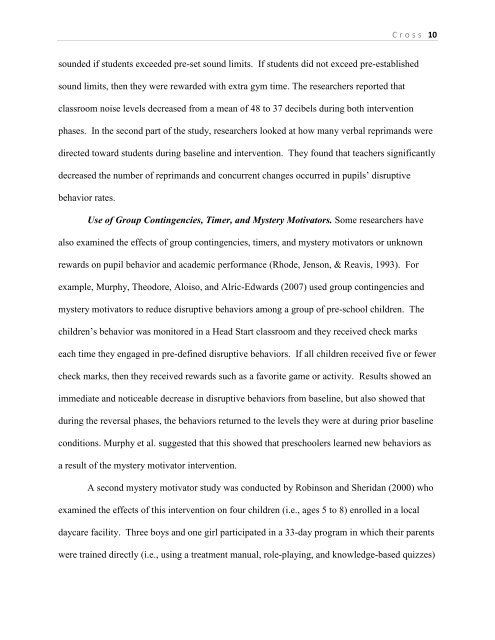THE EFFECTS OF A TIMER AND MYSTERY MOTIVATORS ON THE ...
THE EFFECTS OF A TIMER AND MYSTERY MOTIVATORS ON THE ...
THE EFFECTS OF A TIMER AND MYSTERY MOTIVATORS ON THE ...
Create successful ePaper yourself
Turn your PDF publications into a flip-book with our unique Google optimized e-Paper software.
C r o s s 10<br />
sounded if students exceeded pre-set sound limits. If students did not exceed pre-established<br />
sound limits, then they were rewarded with extra gym time. The researchers reported that<br />
classroom noise levels decreased from a mean of 48 to 37 decibels during both intervention<br />
phases. In the second part of the study, researchers looked at how many verbal reprimands were<br />
directed toward students during baseline and intervention. They found that teachers significantly<br />
decreased the number of reprimands and concurrent changes occurred in pupils’ disruptive<br />
behavior rates.<br />
Use of Group Contingencies, Timer, and Mystery Motivators. Some researchers have<br />
also examined the effects of group contingencies, timers, and mystery motivators or unknown<br />
rewards on pupil behavior and academic performance (Rhode, Jenson, & Reavis, 1993). For<br />
example, Murphy, Theodore, Aloiso, and Alric-Edwards (2007) used group contingencies and<br />
mystery motivators to reduce disruptive behaviors among a group of pre-school children. The<br />
children’s behavior was monitored in a Head Start classroom and they received check marks<br />
each time they engaged in pre-defined disruptive behaviors. If all children received five or fewer<br />
check marks, then they received rewards such as a favorite game or activity. Results showed an<br />
immediate and noticeable decrease in disruptive behaviors from baseline, but also showed that<br />
during the reversal phases, the behaviors returned to the levels they were at during prior baseline<br />
conditions. Murphy et al. suggested that this showed that preschoolers learned new behaviors as<br />
a result of the mystery motivator intervention.<br />
A second mystery motivator study was conducted by Robinson and Sheridan (2000) who<br />
examined the effects of this intervention on four children (i.e., ages 5 to 8) enrolled in a local<br />
daycare facility. Three boys and one girl participated in a 33-day program in which their parents<br />
were trained directly (i.e., using a treatment manual, role-playing, and knowledge-based quizzes)
















